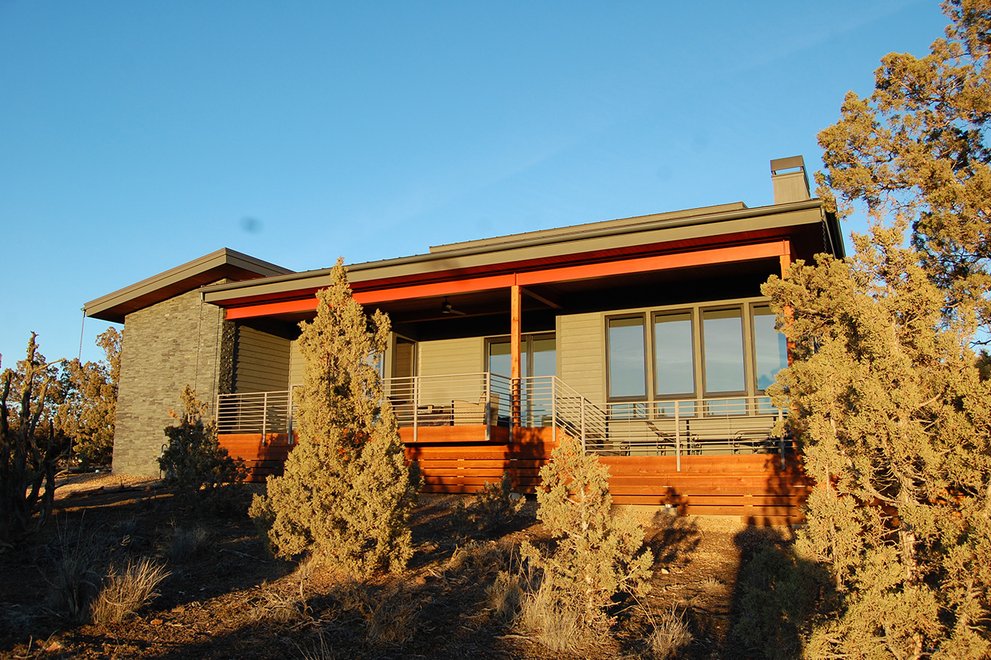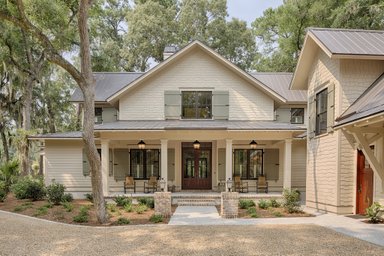Service men and women had returned from overseas. Young
adults were doubling up with their parents, unable to find decent-paying jobs. Traditional
homes remained beyond the financial reach of many. In the midst of a severe
housing crisis, the nation looked to factory-produced housing as a solution. Sound familiar? The scenario almost describes current
housing conditions, given the thousands of veterans returning from the Middle
East, debt-ridden young adults living with their parents, and the country’s
fascination with modular housing. Instead, this was the housing condition the United
States faced after World War II.
Inventor/designer/futurist Buckminster Fuller (the much later geodesic dome was his idea) proposed a solution – his 1,017-square-foot Dymaxion house, built from leftover airplane parts. Fuller invented the name by combining parts of the words dynamic, maximum, and tension. The modular, easy-to-clean, portable homes could be assembled in two days. They would function in the coldest and the hottest climates, relying on processes found in nature. They sold for only $6,500, including shipping. More than 3,000 people made the journey to the Beech Aircraft factory in Wichita, Kansas to sneak a peak. The Dymaxion home capitalized on wartime research that had advanced the technology of Lucite and Plexiglas, aluminum and other metal alloys, and plywood. Forbes magazine declared that the dwelling machine was likely “to produce greater social consequences than the introduction of the automobile.”
Flash forward 70 years and only one Dymaxion house remains – at the Henry Ford Museum in Suburban Detroit. The house was pieced together from the parts of two prototypes. It took the museum’s engineers more than a year, using the original drawings, to reconstruct the house in the way the architect/inventor initially intended. It’s as though a spaceship from the past has landed to chart the future. Fuller, who had been developing prototypes of the dwelling machine for 15 years, designed an inexpensive, sustainable house with no wasted space. Homes could be shipped in pieces weighing no more than 10 pounds that homeowners could bolt together on site in a couple of days. Backers estimated that the Wichita plant could produce a quarter million homes a year, using the same labor that had built planes.
A central stainless-steel mast, anchored by a small foundation, facilitated the revolutionary shape.
Spokes spread out from the top of the mast to hold up the roof, and beams radiated out to support the floor. Homebuyers would need a crew to dig a hole, sink the mast, and raise the frame. But then a two-person team could bolt the house together within a day. The beauty of the approach was that the homes could be disassembled and moved to the next location where owners wanted to live, saving material that would otherwise be consumed for a second house. The design is sustainable, to say the least. It features a natural ventilation system. The dome shape induces a vortex that sucks cooler air downward, if the dome is vented properly – with a single overhead vent and vents along the periphery. A rooftop ventilator changes the air every six minutes, drawing air through screened walls.
The home anticipated the country’s evolving fascination with factory-built housing. “Prefabrication may be the answer to churning out the millions of homes our country needs,” intones the narrator of a jumpy newsreel produced at the time. “Produced in factories, where the weather is never a problem, trucked to their location, and assembled in a speedy and efficient manner, these dwellings are helping to fill the housing gap.” The circular form of the home allowed Americans to live more cheaply and efficiently, according to marketing material produced at the time. Living in a round house, it read, is “the smart thing to do.” A dome shape provides more interior space and allows air to flow unrestricted through the house.
The aerodynamic design also results in less heat loss. Utilities, bundled around the mast, supported built-in plumbing, heating, and air conditioning. Locating utilities near the central stack meant that interior walls
could be easily moved to customize spaces. The floor plan consisted of a combined living and dining room anchored by a metal fireplace, two bedrooms, two baths, and a kitchen. Guests coming for the weekend? No problem. Adding extra wall panels could quickly convert half the living room into a guest room.
The home included many other modern conveniences. Fuller designed a “dust-free” hat rack by the door.
Space-saving carousel shelving worked in lieu of dressers and closets for storage of clothes and linens. Coats and shoes were stored in automated revolving closets.
A sleek, “all-in-one” kitchen included built-in appliances.
A two-piece modular bathroom module with circular fixtures made for easy cleaning – and water savings. The bathroom included a composting toilet and a fogger that used compressed air to emit small water particles for showers. The home included a greywater system as well. Roof joints channeled rainwater to an internal gutter and drain. Water was routed to a cistern in the basement then used to water the lawn and garden.
Despite great interest – more than 3,700 families wanted more information -- the house never went into official production. Backers couldn’t raise the $10 million needed to seed the venture. Asked to simplify the design to lower costs, Fuller refused, creating an impasse that eventually led him to leave the company. Only two models were ever built. A video next to the museum exhibit notes that while executives at Fuller Homes squabbled, other developers got 1.2 million more conventional houses underway in 1946. Most of these homes – Cape Cods, Ranches, and Colonials – paid little attention to the social, environmental, and building issues addressed by the Dymaxion house. Tradition ultimately prevailed.
Boyce Thompson is the former Editorial Director of Builder Magazine and the author of The New New Home.
Inventor/designer/futurist Buckminster Fuller (the much later geodesic dome was his idea) proposed a solution – his 1,017-square-foot Dymaxion house, built from leftover airplane parts. Fuller invented the name by combining parts of the words dynamic, maximum, and tension. The modular, easy-to-clean, portable homes could be assembled in two days. They would function in the coldest and the hottest climates, relying on processes found in nature. They sold for only $6,500, including shipping. More than 3,000 people made the journey to the Beech Aircraft factory in Wichita, Kansas to sneak a peak. The Dymaxion home capitalized on wartime research that had advanced the technology of Lucite and Plexiglas, aluminum and other metal alloys, and plywood. Forbes magazine declared that the dwelling machine was likely “to produce greater social consequences than the introduction of the automobile.”
Flash forward 70 years and only one Dymaxion house remains – at the Henry Ford Museum in Suburban Detroit. The house was pieced together from the parts of two prototypes. It took the museum’s engineers more than a year, using the original drawings, to reconstruct the house in the way the architect/inventor initially intended. It’s as though a spaceship from the past has landed to chart the future. Fuller, who had been developing prototypes of the dwelling machine for 15 years, designed an inexpensive, sustainable house with no wasted space. Homes could be shipped in pieces weighing no more than 10 pounds that homeowners could bolt together on site in a couple of days. Backers estimated that the Wichita plant could produce a quarter million homes a year, using the same labor that had built planes.
A central stainless-steel mast, anchored by a small foundation, facilitated the revolutionary shape.
Spokes spread out from the top of the mast to hold up the roof, and beams radiated out to support the floor. Homebuyers would need a crew to dig a hole, sink the mast, and raise the frame. But then a two-person team could bolt the house together within a day. The beauty of the approach was that the homes could be disassembled and moved to the next location where owners wanted to live, saving material that would otherwise be consumed for a second house. The design is sustainable, to say the least. It features a natural ventilation system. The dome shape induces a vortex that sucks cooler air downward, if the dome is vented properly – with a single overhead vent and vents along the periphery. A rooftop ventilator changes the air every six minutes, drawing air through screened walls.
The home anticipated the country’s evolving fascination with factory-built housing. “Prefabrication may be the answer to churning out the millions of homes our country needs,” intones the narrator of a jumpy newsreel produced at the time. “Produced in factories, where the weather is never a problem, trucked to their location, and assembled in a speedy and efficient manner, these dwellings are helping to fill the housing gap.” The circular form of the home allowed Americans to live more cheaply and efficiently, according to marketing material produced at the time. Living in a round house, it read, is “the smart thing to do.” A dome shape provides more interior space and allows air to flow unrestricted through the house.
The aerodynamic design also results in less heat loss. Utilities, bundled around the mast, supported built-in plumbing, heating, and air conditioning. Locating utilities near the central stack meant that interior walls
could be easily moved to customize spaces. The floor plan consisted of a combined living and dining room anchored by a metal fireplace, two bedrooms, two baths, and a kitchen. Guests coming for the weekend? No problem. Adding extra wall panels could quickly convert half the living room into a guest room.
The home included many other modern conveniences. Fuller designed a “dust-free” hat rack by the door.
Space-saving carousel shelving worked in lieu of dressers and closets for storage of clothes and linens. Coats and shoes were stored in automated revolving closets.
A sleek, “all-in-one” kitchen included built-in appliances.
A two-piece modular bathroom module with circular fixtures made for easy cleaning – and water savings. The bathroom included a composting toilet and a fogger that used compressed air to emit small water particles for showers. The home included a greywater system as well. Roof joints channeled rainwater to an internal gutter and drain. Water was routed to a cistern in the basement then used to water the lawn and garden.
Despite great interest – more than 3,700 families wanted more information -- the house never went into official production. Backers couldn’t raise the $10 million needed to seed the venture. Asked to simplify the design to lower costs, Fuller refused, creating an impasse that eventually led him to leave the company. Only two models were ever built. A video next to the museum exhibit notes that while executives at Fuller Homes squabbled, other developers got 1.2 million more conventional houses underway in 1946. Most of these homes – Cape Cods, Ranches, and Colonials – paid little attention to the social, environmental, and building issues addressed by the Dymaxion house. Tradition ultimately prevailed.
Boyce Thompson is the former Editorial Director of Builder Magazine and the author of The New New Home.






